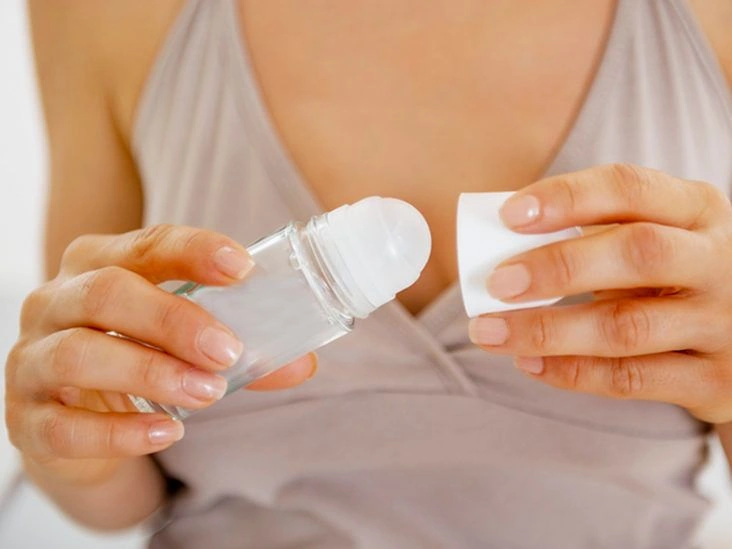Crystal deodorant is an alternative deodorant composed of a natural mineral salt called potassium alum, also referred to as potassium aluminum sulfate. It possesses antimicrobial qualities that help reduce odor-producing bacteria.
Potassium alum has been employed as a deodorant across Southeast Asia for centuries, and crystal deodorant has grown in popularity in Western countries over the past few decades.
Its rising appeal is linked to factors such as:
- natural composition
- affordability
- perceived health advantages, including claims of a lower breast cancer risk
There’s a common concern that absorption of aluminum and other chemicals through the underarm might raise the risk of breast cancer. However, according to current scientific reviews, there’s no solid research supporting this connection.
Even so, some people prefer to minimize unnecessary chemicals in their personal care products whenever possible.

Clinical evidence establishing the benefits of crystal deodorant is limited, and many reported advantages are anecdotal. Some users praise it, while others find it ineffective. Ultimately, results vary with individual body chemistry and personal choice.
Continue reading to discover how this straightforward deodorant might be beneficial for you.
How to use crystal deodorant
Crystal deodorant is sold as a stone, roll-on, or spray, and occasionally as a gel or powder. Stone forms may be standalone or attached to a plastic holder.
The ideal time to apply it is immediately after showering or bathing, while your underarms are freshly cleaned and slightly damp. You can also use it on other body areas, but consider keeping a separate stone for that purpose.
Run the stone under water briefly, then apply to clean underarms. Avoid soaking it. If the stone is fixed in a plastic base, prevent water from entering the holder—storing the stone upside down after use can help.
Apply with upward and downward strokes or circular motions, wetting the stone as needed until you’ve covered the entire underarm.
It should glide on smoothly; discard any cracked or rough-edged stones to prevent cuts or irritation. Continue rubbing until the skin feels dry.
When using a spray, you might wrap a towel around your torso to catch any drips. A faint chalky residue can remain after application, so wait for it to dry before dressing.
Crystal deodorant can remain effective for up to 24 hours. To reapply between showers, clean the underarm with rubbing alcohol on a cotton pad before reusing.
The salt in crystal deodorant helps eliminate bacteria responsible for underarm odor. You may still perspire, but the scent is often reduced or removed.
Crystal deodorant benefits
A key attraction of crystal deodorant is avoiding the synthetic ingredients found in many conventional deodorants.
Using deodorants and antiperspirants can limit your body’s natural sweating, and some worry this may prevent the release of toxins and lead to clogged pores. Crystal deodorant doesn’t block sweating, focusing instead on neutralizing odor-causing bacteria.
Typical deodorants and antiperspirants may include ingredients such as:
- aluminum compounds
- parabens
- steareths
- triclosan
- propylene glycol
- triethanolamine (TEA)
- diethanolamine (DEA)
- artificial colorants
Many of these components are suspected of irritating sensitive skin or posing health concerns. Always check the ingredient list, even for products labeled “natural.”
Note that scented crystal deodorants may contain additional substances—read the full ingredient list carefully.
A stone crystal deodorant can last for several months, though it might eventually develop an odor. This is less likely if you keep your underarm hair trimmed or removed.
If odor becomes an issue, consider a crystal deodorant spray, which won’t directly contact the skin. Prices vary but are generally similar to conventional products and can be more economical, particularly with stone types.
Crystal deodorant side effects
Switching from an antiperspirant to crystal deodorant may lead to increased sweating initially.
During this adjustment period you might also notice stronger body odor, but this typically subsides as your body adapts.

Crystal deodorant can cause rashes, itching, or irritation, especially if applied to broken skin or right after shaving or waxing. It may trigger a contact dermatitis reaction, manifesting as inflammation, dryness, or redness.
Avoid using it on sensitive skin and stop use if irritation persists.
Takeaway
Crystal deodorant is one natural alternative to conventional products.
Its suitability depends on personal preference and how it interacts with your body chemistry, lifestyle, and clothing choices. It may perform differently depending on the season.
Dietary and lifestyle adjustments can also help reduce body odor. If crystal deodorant isn’t effective for you but you still prefer a natural option, explore other natural deodorant choices.


















Leave a Reply
You must be logged in to post a comment.